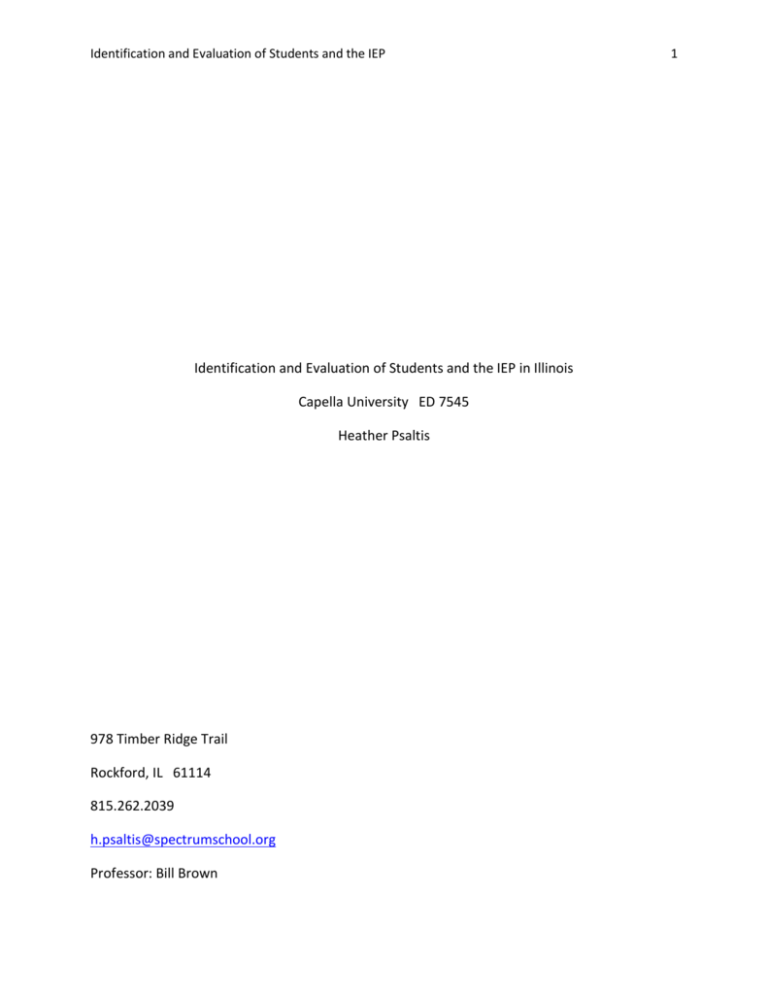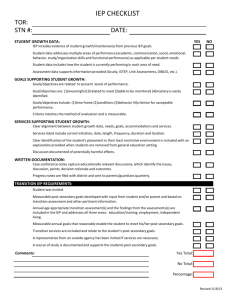File - Heather Psaltis
advertisement

Identification and Evaluation of Students and the IEP Identification and Evaluation of Students and the IEP in Illinois Capella University ED 7545 Heather Psaltis 978 Timber Ridge Trail Rockford, IL 61114 815.262.2039 h.psaltis@spectrumschool.org Professor: Bill Brown 1 Identification and Evaluation of Students and the IEP 2 The State of Illinois has specific guidelines about the identification and evaluation of students potentially needing special education services. It adopted RTI, Response to Intervention, with the goal that each district in the state would have a complete plan for implementing RTI by the 2010-2011 school year (isbe.net). The state guidelines are aligned with IDEA 2004, and the state has clear guidelines for compliance. Individual school districts within the state are responsible for creating a process in alignment with IDEA and incorporating RTI. Response to Intervention is an approach to identifying students with specific learning disabilities that replaces the former discrepancy-based format. It serves to measure progress over time with appropriate, scientifically proven interventions to determine the existence of a true LD and to rule out cultural and socio-economic bias that leads to over-identification of students due to other factors. At the beginning of this school year, Rockford Public Schools fully moved to the new format, with new IEP software, new identification processes and new guidelines. Some students will come to school having accessed the Illinois Early Intervention, or birth to age 3 services and an initial IEP will be written at the preschool level. The k-12 process of identification, evaluation, eligibility determination, advantages of special education categories for students and legal guidelines for creating an IEP are detailed below. Identification Process Based on state and federal guidelines, RPS #205 follows an RTI approach to identifying students in need of intervention. For students struggling with behavioral or academic issues, as well as at risk students, it has adopted a tiered approach to intervention designed to be used before a student is referred for special education assessment. The RTI team in each building is Identification and Evaluation of Students and the IEP 3 designed to problem solve individual student issues, and to suggest classroom tier one interventions. The RTI team also provides curriculum support and monitors progress to determine if a more intensive, tier two level of support is indicated. Tier two may involve extra support in a small group setting for direct reading or math instruction, or behavioral interventions tracked by the RTI team. If the first two levels of intervention are not sufficient, the school psychologist and/ or special education teacher will add another layer of intervention to the student’s program, which may involve targeted support from the reading specialist or social worker and additional consultation with the classroom teacher. For example, a teacher referring a student with behavioral issues would receive support and intervention ideas for the student in tier one, would add behavioral charts and direct instruction in social skills at level two, and have classroom access to the social worker for tier three. The district PBIS, or Positive Behavior Intervention and Support plans should be implemented as appropriate beginning with tier two. Throughout the tiers, instruction and programming content must be aligned to the Illinois Learning Standards and Assessment Frameworks. The interventions must match student needs as identified through universal screening and ongoing progress monitoring tools (isbe.net). Tier one is accessible to any student in the regular classroom, and tier two academic support is addressed during literacy and numeracy intervention blocks, which are scheduled in each building (isbe.net). The RTI process is designed to provide classroom teachers with the support they need early in the process of supporting struggling students to avoid unnecessary special education referrals. If it has been determined that the tiers do not provide adequate support, the RTI team and classroom teacher will refer the student to the special education Identification and Evaluation of Students and the IEP 4 team for evaluation. As mentioned, students with significant disabilities will have been identified through early intervention, Illinois’ birth - 3 support system, or through Child Find (isbe.net), the preschool intervention program through RPS #205. Evaluation Once it has been determined that the tiers of student support are not enough to show a student’s adequate progress, consent from the parent or guardian is secured so that a full psycho-educational evaluation of the student can take place. Once written consent is given, the team has 60 school days in which to complete vision, hearing, achievement and cognitive assessments. Based on the RTI information, students may also be assessed for speech, occupational or physical therapy, behavioral or autism spectrum disorders. Vision and hearing issues must be ruled out before other testing occurs. If a student has a medical diagnosis, such as ADHD or Bipolar Disorder and PBIS plans have been unsuccessful in conjunction with a section 504 plan, students may be evaluated for services under the Other Health Impaired (OHI) category. Parents or guardians are interviewed medical histories for all assessments, and may be interviewed by a social worker if indicated. The classroom teacher will include the RTI and classroom interventions used prior to referral as part of the team documentation. Eligibility for Services Once the multidisciplinary team has completed its assessments, combined with classroom and parent input as well as functional assessments of current functioning, the entire team will determine a student’s eligibility for special education services (Bartlett, Etscheidt & Weisenstein, 2007). If a student is determined to need special education services, an IEP will be Identification and Evaluation of Students and the IEP 5 developed with team input. In RPS#205, the team typically meets and drafts and IEP to present at the eligibility determination conference with the parent or guardian, as the same team is needed for both meetings. Parents are notified in advance both in writing and in person at the start of the meeting about their rights and due process. At the initial IEP meeting, specific and measureable goals are written for each student with access to the regular curriculum, standards and assessments in mind. Rarely, students will be considered for alternative assessments in place of the ISAT testing. Part of equal access to the curriculum is assessing students with IEPs using the ISAT with appropriate accommodations (rps205.com). Advantages and Disadvantages of Disability Labels There are advantages that come from disability labels in the form of services. For example, students with cognitive impairments can learn functionally appropriate skills and selfadvocacy in a smaller setting with specialized teachers. Students with behavioral challenges can learn self-regulation techniques and have access to more individualized support that will allow them to transition to the workplace upon graduation. Students with severe learning disabilities have access to innovative technology or instruction to support their struggles with auditory or visual input or to help them generate appropriate output according to their needs. In certain cases, when established by a multidisciplinary team, supports ranging from classroom support to resource support to partial self-contained classrooms are the LRE for a student with disabilities. However, annual reviews and three year reevaluations must be in place to avoid categorically labeling a student and potentially denying them access to the regular curriculum. With the future in mind, and state and federal guidelines as support, labels should be annually Identification and Evaluation of Students and the IEP reviewed to provide the best support within the district continuum of services for students without being too restrictive. In addition, the RTI process is designed to raise intervention levels while avoiding disproportionality of labeling in racial and economic groups. If the focus for special education labeling is on the words individualized, appropriate, free and least restrictive, and the category is determined by a qualified team of educators and the student’s parent or guardian, special education can provide access to much needed services. Conclusion The special education referral, identification and evaluation process has changed significantly in the past two years in Rockford, IL. RTI and IDEA 2004 have created new guidelines that have been explained. Each district in IL will have slightly different levels of support based on funding, which is primarily from local taxes versus state or federal funding (census.gov & Fowler, 2009). The building administrator has an obligation to support staffing and resource allocation in order to meet the requirements detailed above. The process of identification, evaluation, eligibility determination, advantages of special education categories for students and legal guidelines for creating an IEP are an important part of the educational process, and should be understood by all stakeholders in the regular and special education arenas. 6 Identification and Evaluation of Students and the IEP 7 References Bartlett, L., Etscheidt, S., Weisenstein, G., (2007). Special education law and practice in public schools. Upper Saddle River, NJ: Pearson. Illinois General Assembly. (2010). Retrieved from http://www.ilga.gov/legislation/ilcs/ilcs4.asp?DocName=010500050HArt%2E+1 4A&ActID=1005&ChapterID=17&SeqStart=108200000&SeqEnd=110300000 Illinois State Board Of Education. (2010). Retrieved from http://webs.rps205.com/curriculum/lp.html Fowler, F. C. (2009). Policy studies for educational leaders: An introduction. Upper Saddle River, NJ: Pearson. Rockford Public Schools. (2010). Retrieved from http://webs.rps205.com/district/Policyindex.html United States Census Bureau. (2010). Retrieved from http://www2.census.gov/govs/school/08f33pub.pdf Identification and Evaluation of Students and the IEP 8






